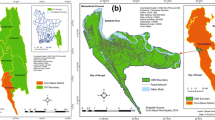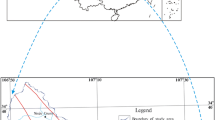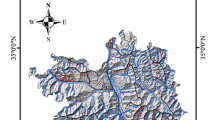Abstract
This paper presents a landslide susceptibility analysis in Jeju Island, South Korea using AHP (Analytic Hierarchy Process) and ANN (Artificial Neural Network) methods. To assess the landslide susceptibility, seven factors which affect the landslide occurrence were selected as: slope, aspect, soil type, geological type, rainfall intensity, forest and land cover. According to the relation between the above factors and landslide distribution, the weight value and rating value of each factor were calculated using AHP and ANN. Finally, we get two susceptibility maps using AcrView software through weighted overlay GIS (Geographic Information System) method. The comparative analysis reveals that the slope, rainfall intensity, soil and forest play important roles in landslide occurrence. From the results, we also found that AHP and ANN methods can be used to analyze landslide susceptibility using the data from the different area and the ANN method was more suitable and effective than AHP method.
Similar content being viewed by others
References
Ayalew, L., Yamagishi, H., Marui, H., and Kanno, T. (2005). “Landslides in Sado Island of Japan: Part II. GIS-based susceptibility mapping with comparisons of results from two methods and verifications.” Engineering Geology, Vol. 81, No. 4, pp. 432–445.
Carrara, A. (1983). “A multivariate model for landslide hazard evaluation.” Mathematical Geology, Vol. 15, No. 3, pp. 403–426.
Cheon, K. (2005). A method of determining landslide susceptibility area using GIS, PhD Thesis, Gangwon University Graduate School, pp. 71–75.
Dai, F. C., Lee, C. F., Li, J., and Xu, Z. W. (2001). “Assessment of landslide susceptibility on the natural terrain of Lantau Island, Hong Kong.” Environmental Geology, Vol. 43, No. 3, pp. 381–391.
Ercanoglu, M. and Gokceoglu, C. (2004). “Use of fuzzy relations to produce landslide susceptibility map of a landslide prone area (West Black Sea Region, Turkey).” Engineering Geology, Vol. 75, Nos. 3–4, pp. 229–250.
Guzzetti, F., Carrara, A., Cardinalli, M., and Reichenbach, P. (1999). “Landslide hazard evaluation: A review of current techniques and their application in a multi-scale study, Central Italy.” Geomorphology, Vol. 31, Nos. 1–4, pp. 181–216.
Hagan, M. T., Demuth, H. B., and Beale, M. (1996). Neural network design, PWS Publishing, Boston.
Jensen, J. R., Qiu, F., and Ji, M. (1999). “Predictive modeling of coniferous forest age using statistical and artificial neural network approaches applied to remote sensing data.” International Journal of Remote Sensing, Vol. 20, No. 14, pp. 2805–2822.
Kanellopoulas, I. and Wilkinson, G. G. (1997). “Strategies and best practice for neural network image classification.” International Journal of Remote Sensing, Vol. 18, No. 4, pp. 711–725.
Kavzoglu, T. (2001). An investigation of the design and use of feed-forward artificial neural networks in the classification of remotely sensed images, PhD Thesis, University of Nottingham, School of Geography, p. 306.
Kim, G. (2000). GIS introduction, Daiyeongsa, pp. 206–225.
Komac, M. (2006). “A landslide susceptibility model using the analytical hierarchy process method and multivariate statistics in perialpine Slovenia.” Geomorphology, Vol. 74, Nos. 1–4, pp. 17–28.
Lee, S. (2000). Development and application of landslide susceptibility analysis techniques using Geographic Information System (GIS), PhD Thesis, Graduate School Yonsei University, pp. 1–21.
Lee, M. (2003). Landslide susceptibility analysis using remote sensing, GIS, and neural network in the Kangneung area, Thesis for the Degree of Master, Graduate School Yonsei University, pp. 1–23.
Lee, S. (2005). “Application of logistic regression model and its validation for landslide susceptibility mapping using GIS and remote sensing data.” International Journal of Remote Sensing, Vol. 26, No. 7, pp. 1477–1491.
Lee, S., Choi, J., and Min, K. (2004). “Probabilistic landslide hazard mapping using GIS and remote sensing data at Boun, Korea.” International Journal of Remote Sensing, Vol. 25, No. 11, pp. 2037–2052.
Lee, S. and Min, K., (2001). “Statistical analysis of landslide susceptibility at Yongin, Korea.” Environmental Geology, Vol. 40, No. 9, pp. 1095–1113.
Nielsen, T. H., Wrigth, R. H., Vlasic, T. C., and Spangle, W. E. (1979). “Relative slope stability and land-use planning in the San Francisco Bay region, California, US.” Geological Survey Professional Paper, p. 944.
Pradhan, B. and Lee, S. (2010). “Landslide susceptibility assessment and factor effect analysis: backpropagation artificial neural networks and their comparison with frequency ratio and bivariate logistic regression modelling.” Environmental Modelling & Software, Vol. 25, No. 6, pp. 747–759.
Saaty, T. L. (1980). The analytic hierarchy process, McGraw-Hill, pp. 11–76.
Suzen, M. L. and Doyuran, V. (2004). “Data driven bivariate landslide susceptibility assessment using geographical information systems: A method and application to Asarsuyu catchment, Turkey.” Engineering Geology, Vol. 71, Nos. 3–4, pp. 303–321.
Turner, A. K. and Schuster, R. L. (Eds.) (1996). Landslides: Investigation and mitigation, Special Report 247 Transportation Research Board and National Research Council, National Academy Press, Washington, D.C., p. 673.
van Westen, C. J. (1997). Statistical landslide hazard analysis, ILWIS 2.1 for Windows application guide, ITC Publication, Enschede, pp. 73–84.
Yalcin, A. (2008). “GIS-based landslide susceptibility mapping using analytical hierarchy process and bivariate statistics in Ardesen (Turkey); Comparisons of results and confirmations.” Catena, Vol. 72, No. 1, pp. 1–12.
Yesilnacar, E. and Topal, T. (2005). “Landslide susceptibility mapping: A comparison of logistic regression and neural networks methods in a medium scale study, Hendek region (Turkey).” Engineering Geology, Vol. 79, Nos. 3–4, pp. 251–266.
Author information
Authors and Affiliations
Corresponding author
Rights and permissions
About this article
Cite this article
Quan, HC., Lee, BG. GIS-based landslide susceptibility mapping using analytic hierarchy process and artificial neural network in Jeju (Korea). KSCE J Civ Eng 16, 1258–1266 (2012). https://doi.org/10.1007/s12205-012-1242-0
Received:
Revised:
Accepted:
Published:
Issue Date:
DOI: https://doi.org/10.1007/s12205-012-1242-0




